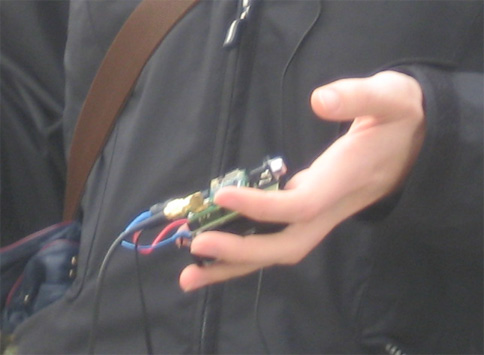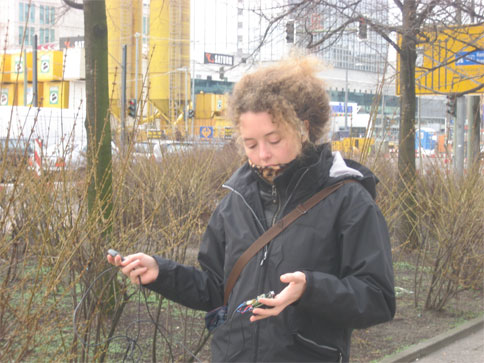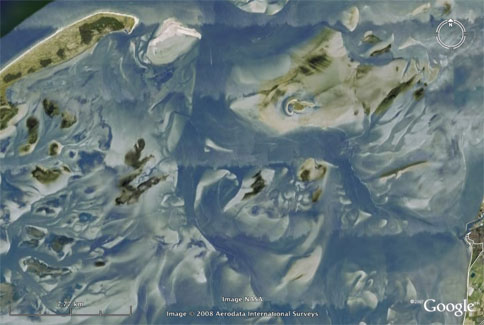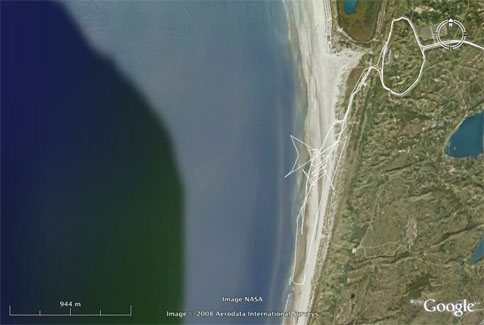[ 1 comment ] ( 42 views )
by "mapping" i refer to decisions of how to transform data into sound
this is a relatively simple example:
GPS data is limited in its ranges and frequency of change
the sound is limited by the computing power of the small device
i need identify the prominent characteristics of movement and change in the data and map this to suitable changes in audio. but to do this I need to have an idea of the density of the soundfield I will make, how perceivable changes in data will be, how the characteristics of movement will be traceable in the final sound.
the data has specific numerical ranges and limits. the sound is only limited by human hearing range and distortion of the audio signal. so choices have to be made at the specific level of numerical transformations into audio processes and the final audible result will be particular to those choices.
the sonification of data implies an obligation to choose sounds, and engage in the sonic as composition and as a field of emotive potential to the listener, basically pure sound overlayed or underlayed with patterns of meaning that may or may not be apparent in the audible experience.
[ 1 comment ] ( 39 views )
GSV satellite data describes the changing envelope and stereo placement of the electronic sounds, combined with the frogs (from David Dunn's "Why do Whales and Children Sing")
Here the GSV data is different because other satellites are being tracked. I'm experimenting with different ways of sonifying the RMC (long/lat) data and altitude, here the noise in the background is filtered according to the changes.
[ 1 comment ] ( 32 views )
David Dunn's excellent recent article "Acoustic Ecology and the Experimental Music Tradition"
http://www.newmusicbox.org/article.nmbx?id=5399
[ add comment ] ( 22 views )
Amphibian is a futuristic vision / audition into a world on the transitional spaces between water and land, the deltas and coastlines that will shift in constitution over the coming years. Our blind guidance of technologies of navigation systems starts to morph into a techno-intuition of amphibious involvement with environment. Listening to the orbiting satellites we can hear more than our location on a grid, asking us to re-assess and re-negotiate our relation with the environment.
imagine:
satellites,
between land based and in air
to on and under water
now think of coastlines and deltas
and the shifting water line
the altitude trace above and below water-level
the wetness of the sound and the dryness of the sound
now imagine the sound of amphibians
the frogs
towards an amphibious state
of techno-intuition
coastlines are the area of change
if sea-level rises
we are moving underwater
this is dormant in the consciousness
(as is noah's ark)
so the sound will become wetter
(and we will become amphibian)
we run on this line of rising water
blue underwater in air
whale amphibian
sound water
liquid air waves
locating my beach in the sky
cloud surfing
under liquid form unity of substance
float between states
states at edge make a
breaking wave
thunder from location data
[ add comment ] ( 26 views )
these prototype sounds will be developed for the final version; but even now it's easy to hear the movements of the two kinds of data, the satellites themselves (cricketing) and the long/lat position (frogging)
[ add comment ] ( 21 views )
Last week I collected the prototype of the GPS/sound instrument from Sukandar's studio in Berlin. These photos show the bare boards receiving the GPS data and converting it to sounds using PDa. It's tiny! The plan now is to build these elements into an integrated instrument.


[ add comment ] ( 452 views )
read damian's report
"I was brought on board this project to help out with Pure Data patch development. Specifically, I was to:
- write a parser for NMEA data in Pd;
- help Yolande translate existing Max/MSP patches to Pd;
- figure out how to connect the NMEA parser to the sound patches (networking protocol);
- ensure sound works on the PDa version of Pd."
[ add comment ] ( 20 views )
Working on the GPS data (NMEA), receiving, sorting, mapping to sounds and movements in space. With Damian at NIMK. Main issues: GPS parser, to read in the stream of data and make it useful for sound production.
I'm interested in the info of the satellites themselves, the PRN number, elevation, azimuth and signal/noise ratio (often called signal strength). This comes in the GPGSV sentence of the data, there seem to be up to 32 satellites possible but only a maximum of 12 will be seen at any one time. We were getting between 5 and 10 in the artlab on the top floor in NIMK. It's clear to see the changes over time as the satellites move. I imagine each satellite with their own unique sound which is transformed over time by the three parameters (elevation, azimuth, SNR). Damian made a patch that reads all the data but selects the four satellites with best signal, so that when one moves out of range and dissappears it's replaced by another.
The second layer is the location data, or minimum navigation data called GPRMC, which gives longitude, latitude, time, date, speed, track degrees true etc. This is the typical layer used for navigation and is calculated from the satellite positions. It refers to where the player is, not where the satellites are. I want to use this as a different layer of sound in the piece. We talked about ideas of scaling this data for different speeds over the ground, walking, cycling, driving, flying etc - how to keep a sonic identity of a specific place if the data is scaled according to speed. It might be that Brussels ends up sounding like Amsterdam if going fast, but not if walking, which is a nonsense... Is the scaling necessary then? I have to try with the sound, I think it's probably a sonic issue.
Spatialising this sound according the position of the satellites, or the movement of the player. Does this map directly to the real world direction, in which case we need to use a compass, or does this relate to the body of the person? This is different in the portable version and the static installation version.
[ add comment ] ( 23 views )
Having thoroughly researched the various technical options for developing this piece, we've decided to concentrate on building specifically designed instruments using Gumstix hardware running a Linux operating system and Pure Data /PDa software environment. This addresses the specific requirements of consistent GPS data translated into good quality live stereo sound. It also allows more flexibility in the design of the final instrument, which maybe incorporated into the headphones (still to be decided).
http://www.gumstix.com
http://gige.xdv.org/pda/index.php
[ add comment ] ( 25 views )
It's really exciting to have got together the following team of experts together to develop this project!
Sukandar Kartadinata www.glui.de - main technical developer, electronics at board level
Damian Stewart www.frey.co.nz - programming PD and PDa
STEIM/Jorgen www.steim.org - mechanical development
V2/Stock and Simon www.v2.org - advisory/discussion role email, on Gumstix development hardware and software
NIMK/Yolande www.yolandeharris.net- artist, research and coordination of project ideas and technical production
[ add comment ] ( 25 views )
14 Jan - technical research meeting, Stock and Simon @ V2 Rotterdam
21-31 Jan - prototype development, Sukandar @ Berlin, Damian and Yolande @ NIMK Amsterdam.
04-15 Feb - prototype testing, audio development, Yolande @ NIMK,
18-29 Febr- final instrument development, Sukandar Yolande Jorgen Damian @ STEIM and NIMK
3 March - six finished instruments
04-27 March - final refinements
28 March - opening exhibition @ NIMK, Amsterdam
[ add comment ] ( 21 views )


[ add comment ] ( 20 views )
To breath, to walk, to swim, to rhythm.
The small boat stops becalmed in the middle of the sea, I climb overboard and swim away, then return towards the bow and together we move forwards at the same speed through the water.
The horizon stays at the same distance however far we move towards it. We are sailing forwards but remain in the absolute centre of a disk.
Learning to swim front crawl taught me how to breathe, how to stop salt water flooding down my nose making me choke at every breath.
I breath every two strokes, sometimes every three, whilst my view shifts from the underwater world, cuts through the crumpled surface light and sees the water level and the sky in a second before returning underwater.
Conscious of the responsibility that I am my own engine, as I breathe out through my nose the bubbles rise past my ears with a loud pressure.
The sun is extremely bright around noon so I have to use all three shades on the sextant telescope as I pull down the sun to rest its lower limb on the horizon.
Sleeping on deck ... the sun sets, the moon rises, the moon sets, the planets follow it across the sky, the sun rises ... the sun sets, the moons rises, the planets follow it, the sun rises, the moon sets .... the sun sets, the planets follow it, the moon rises, the sun rises, the moon sets ...
As I walk I remember, and the more I walk the more I remember incidents that I never thought memorable.
[ 1 comment ] ( 36 views )
how can an electronic trace contain my feelings, my memories? how can I recognize people and places in an abstract sound of clicks and tones? how personal is this, how exclusive, how intimate, how possible to share?
these sounds are made from a collection of traces of my journeys (physical, spiritual, emotional and creative) over 2007... but what do you hear and feel?
it's a paradox of invisible memories, searching out an electronic intimacy.
[ add comment ] ( 24 views )
balance and continual shifting of sails and weight in response and anticipation of wind and sea shifts. the precision is intense - the more finely tuned the sailor and the boat, the better performance through the water. i like it as an example of a physical and mental engagement with an instrument (in this case the boat) and the environment, where reactions and anticipations are used at such speed that it is essentially intuitive.
(thanks to my brothers Patrick and Vincent for taking me out to get this shot and talking me through the racing and tuning details - they are Campeones del Mundo! Silver fleet Flying Fifteens, Mallorca 2007)
[ add comment ] ( 23 views )
Thoughts on the shortest day... it's snowing in Amsterdam
I feel like the days have been accelerating and contracting at the same time during the first month of this residency at NIMK. The day of the winter solstice is a good moment for a turn around towards expansion and production.
Until now I've been in a period of investigation, searching through different technical approaches towards building my small GPS-sounding instruments. Most of this was done through experiments, face to face conversations, chance meetings, emailing and internet research. It surprised me that it's so time consuming, but if I didn't do this research I'd be unable to make decisions about the level of technology needed to realize the idea I'm after. This is the 'material' I'm working with after all. It's a balance between research, finding the critical amount of knowledge needed, and keeping open to changes on the ideas level - which results in a state of perpetual tension...
This artistic process has been like the sonic process of filtering and compression, now i want to start building from these fragments into something new.
[ add comment ] ( 22 views )
sounds for the first version of Taking Soundings made at the in 2006/7 KHM in Cologne
[ add comment ] ( 141 views )
Converting my patches between the two programming environments Max/MSP and PD has been easier than I thought. Contrary to what I'd been told, many of the objects are identical if not very similar, and the reference/help patches are often based on the Max documentation. At this stage (which is still early!) I'm working in parallel on both Max and PD testing simple sounds and controls. I have found two GPS NMEA data parser's both available online. The Max version written by Jose Manuel Berenguer can be downloaded here. A PD parser by Alexandre Castonguay is on the puredata.org site here.
[ add comment ] ( 31 views )
a sound/video link
[ 1 comment ] ( 42 views )
If a wave at sea only sounds when it breaks on land, how would one break a sound wave? Following the physics of breaking waves, I found even more interesting techniques of analysing the "skin" of the ocean. But how many ways are there to break a sound wave?
[ add comment ] ( 27 views )
The rediscovery of the techniques of traditional Polynesian navigation in the last half century or less, gives an intertesting perspective on accuracy of navigation and the western development of high technologies for this purpose. These traditional techniques include stars, trade wind directions, waves, using the canoe as a compass, following migrating birds and whales, cloud formations, changes in temperature and smell, floating debris and weed in the sea. All observations of the environment which made crossings of the Pacific Ocean by canoe possible, something we would imagine to be extreme.
[ add comment ] ( 25 views )
Max/MSP and Pure Data (PD)
[ add comment ] ( 22 views )
I am working towards an ideal of intuitive navigation, where a relation to environment (climate, terrain, landscape) is absorbed into an embodied awareness of location and movement, where advances in technological infrastructures for location navigation and weather prediction also become absorbed into our consciousness. At the moment these new technologies are leading us away from this ideal, because they are seen as functional time saving, economic, problem solving. These attitudes are constraining the development towards an expanded and expansive relation to environment. Through my work as composer and media artist I see the potential for sound to act as a catalyst towards a hybrid intuition of navigation. The refusal of sound to be held down by functional constraints makes it a fitting vehicle to explore this potential hybrid form of knowing and experiencing.
[ add comment ] ( 24 views )
I'm refining my search for a technical approach to creating a portable satellite sounding instrument for Sun Run Sun. I'm looking for a flexible open source solution that has possibilities for future changes and developments, both in terms of hardware and software.
I've had mixed responses ranging from "oh yes that's simple" to "you don't want to do that". I was surprised to find a number of negative responses from 'experts', that I'm being unrealistic to look for custom built hardware of such a small scale and expect good quality stereo sound. I don't think this is true at all, so I find it a strange reaction, maybe stemming from a fear of hardware tinkering? Another reaction is to point me to mobile phones and PDA's with a built in GPS. But this introduces fundamental compromises both on a technical and conceptual level - I don't need any of the complexity of these devices (screen, keyboard, network/phone connectivity, software).
I'm going along the lines of a small processor running Linux and PDa, (a version of Pure Data (often used for electronic music)) parsing the data from the GPS (all NMEA data, not just calculated longitude and latitude) for use as the sound generator. One of the requirements is that I can access and program this sound myself, and I prefer to use Max/MSP or PD for this. I'm pretty excited by Gumstix: tiny computers, motherboards and expansion boards, one of which includes a GPS module, the size of a stick of chewing gum, 20mm x 80mm. This could provide just the solution in terms of size, platform, performance and flexibility for future use.
But more work is needed to find the optimal solution.....
[ add comment ] ( 38 views )
The Leonardo Electronic Almanac special issue on locative media from 2006 has a good collection of papers, overviews and example projects Vol 14 issue 03
[ 2 comments ] ( 39 views )
participating in STEIM's (Studio for Electro-Instrumental Music) orientation workshop in Amsterdam, I'm introduced to their software LiSa for live sampling and processing of sound and JunXion to map controller information from all sorts of input devices to varying sound parameters. It means that I compose, control and improvise on the fly, using sounds that i have stored, record or capture, transforming them into new sounds. And I can gesturally control these sounds in multiple ways including assigning and shaping processes. Which is fantastic because it's flexible and fast.
the draw-backs (arguably) are: it only runs on a mac, works with sound samples not synthesis, is built around the low resolution of midi, and it's not open-source... all side-effects of the fact it's been developed by one programmer over many years for one specific performer.
but then my respect for STEIM lies in it's openness to many forms of instrument and music making, without imposing aesthetics or software choices on the many musicians and artists who become involved in one way or another. so what's the extent of 'open' and 'open-source'?
[ add comment ] ( 19 views )
I was at the start of this round-the-world two handed race that left from Barcelona 3 weeks ago. Here you can follow the continuously updated trace of the boats, get the latest weather reports for their area, and see a google animation of the routes taken so far, there is even a game for you to race against the real boats online (when i checked there were more than 500 'skippers' logged in!) I guess this is a nice example of my talk about the split between embodied experience of location and the virtual - but it's the sailors that are experiencing the hybrid form of location...
[ add comment ] ( 57 views )
follow the moderated discussion from 3 december on the Yasmin Mediterranean Art Science Network list on the theme of locative media art
[ add comment ] ( 19 views )
> a concise overview to celestial navigation
> a nice set by step description of how to make a sun-run-sun
[ add comment ] ( 44 views )

 Archives
Archives




